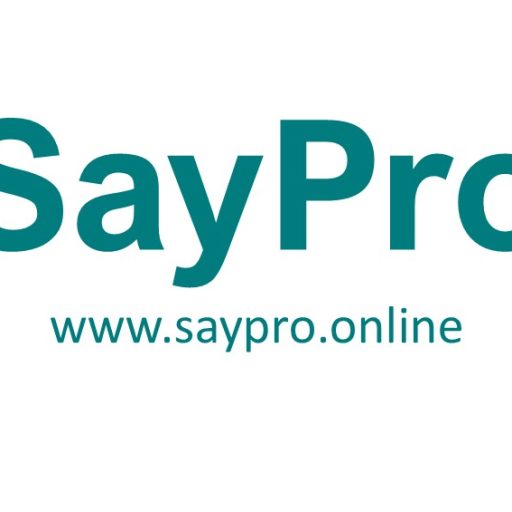Your cart is currently empty!
Tag: sources
SayPro is a Global Solutions Provider working with Individuals, Governments, Corporate Businesses, Municipalities, International Institutions. SayPro works across various Industries, Sectors providing wide range of solutions.
Email: info@saypro.online Call/WhatsApp: Use Chat Button 👇

-
SayPro data collection methods and sources
SayPro Data Collection Methods and Sources
Department: SayPro Monitoring and Evaluation
Function: Data Collection for Monitoring, Learning, and Reporting
Report Reference: SayPro Monthly – June SCLMR-1
Framework: SayPro Monitoring under SCLMR (Strengthening Community-Level Monitoring & Reporting)
I. Data Collection Methods
SayPro employs a mixed-methods approach to ensure that both quantitative and qualitative data are collected for comprehensive program evaluation. Key methods include:
1. Structured Surveys and Questionnaires
- Purpose: To collect standardized quantitative data on project outputs, outcomes, and beneficiary reach.
- Tools Used: Digital platforms like KoboToolbox, ODK, SurveyCTO, and custom SayPro mobile apps.
- Format: Closed-ended questions, Likert scales, checklists, etc.
- Respondents: Beneficiaries, project participants, stakeholders, staff.
2. Key Informant Interviews (KIIs)
- Purpose: To gather in-depth insights from individuals with specialized knowledge (e.g., community leaders, local officials, project staff).
- Format: Semi-structured, one-on-one interviews.
- Focus Areas: Local context, implementation challenges, stakeholder perceptions, strategic input.
3. Focus Group Discussions (FGDs)
- Purpose: To collect group-based qualitative data reflecting community perspectives and shared experiences.
- Participants: Segmented groups (e.g., youth, women, beneficiaries, service providers).
- Facilitation: Guided by trained M&E Officers using thematic discussion guides.
4. Direct Observations
- Purpose: To assess real-time activities, service delivery quality, infrastructure, or community engagement.
- Method: Use of standardized observation checklists and field notes.
- Scope: Training sessions, community events, health services, livelihood activities, etc.
5. Routine Monitoring Forms
- Purpose: To track regular project implementation data and progress against indicators.
- Collected By: Project staff, field officers, and coordinators.
- Frequency: Weekly or monthly, depending on the project.
6. Case Studies and Success Stories
- Purpose: To capture qualitative impact narratives and document change at the individual or community level.
- Method: Interviews, field visits, photo documentation, storytelling frameworks.
7. Feedback and Complaint Mechanisms
- Purpose: To collect real-time beneficiary feedback on services, satisfaction, and complaints.
- Channels: Suggestion boxes, SMS feedback platforms, hotline numbers, WhatsApp, in-person forums.
II. Primary Data Sources
SayPro’s primary data is collected directly from:
- Project Beneficiaries: Individuals, households, and communities participating in or impacted by SayPro programs.
- Field Implementation Staff: Officers and coordinators involved in program delivery.
- Community Stakeholders: Leaders, volunteers, and partner organizations at the local level.
- Training and Event Participants: Individuals engaged in capacity-building sessions or campaigns.
- Service Delivery Points: Health centers, education hubs, entrepreneurship workshops, and other SayPro-run facilities.
III. Secondary Data Sources
SayPro supplements primary data with credible secondary sources to contextualize findings and support triangulation:
- Government Reports and Statistics: National or regional development indicators, census data, and local government publications.
- Partner Organization Reports: Data shared by collaborating NGOs, CBOs, and agencies.
- Academic Research: Relevant studies and publications related to program sectors or communities.
- Internal Historical Data: Data from previous SayPro program cycles, evaluations, and audits.
Conclusion
SayPro’s data collection strategy emphasizes accuracy, inclusivity, and contextual relevance. By combining multiple methods and diverse sources, SayPro ensures that the data used for analysis, reporting, and decision-making—especially in reports like the June SCLMR-1—is both robust and representative. This approach strengthens program accountability, strategic alignment, and impact measurement across all regions.
-

SayPro Case Study Research Template (with sources and references)
SayPro Case Study Research Template
1.SayPro Case Study Title
Provide a clear, descriptive title that reflects the core focus of the case.
2.SayPro Executive Summary (150–200 words)
Summarize the key aspects of the case study: context, challenge, intervention, outcome, and impact.
3.SayPro Background and Context
- Geographical Location:
- Target Population / Beneficiaries:
- Time Frame:
- Implementing Team / Partners:
- Socioeconomic or Political Context:
Explain the background and why the case is significant.
4.SayPro Problem Statement
What issue or need was this case study addressing?
Include data or evidence that supports the problem’s relevance.
5.SayPro Objectives of the Intervention
List the main goals and specific objectives that guided the project or program.
6.SayPro Approach and Methodology
- Design and Implementation Strategy:
- Tools/Technologies Used:
- Stakeholder Engagement:
- Monitoring and Evaluation (M&E):
Describe how the project was carried out and evaluated.
7.SayPro Key Activities
List and explain the major activities carried out, including timelines and responsible parties.
8.SayPro Outcomes and Impact
- Planned vs Achieved Results:
- Qualitative and Quantitative Impact (use data):
- Beneficiary Feedback / Testimonials:
Use tables, charts, or infographics if applicable.
9.SayPro Lessons Learned
Highlight successes, challenges, and what SayPro or others can learn from this case.
10.SayPro Sustainability and Scalability
Is the solution sustainable long-term? Can it be replicated or expanded in other regions or contexts?
11. Recommendations
Practical suggestions for SayPro teams, policymakers, partners, or communities.
12.SayPro Sources and References
List all sources cited or consulted during the case study development. Use APA or Harvard referencing style.
Example:- Smith, J. (2023). Community-Led Development in Sub-Saharan Africa. UNDP.
- World Bank. (2022). Youth Employment Indicators. https://www.worldbank.org/youthdata
- SayPro Internal Report (2024). “Youth Skilling Initiative – Gauteng Region.”
13.SayPro Appendices (if applicable)
- Surveys or Interview Questions
- Additional Data Tables
- Photos (with consent)
- Policy Documents or Frameworks Used
SayPro Notes:
- Always secure written consent when including photos or quotes from beneficiaries.
- Reference all data accurately to ensure credibility and transparency.
- Tailor this template to meet donor or partner requirements when applicable.
